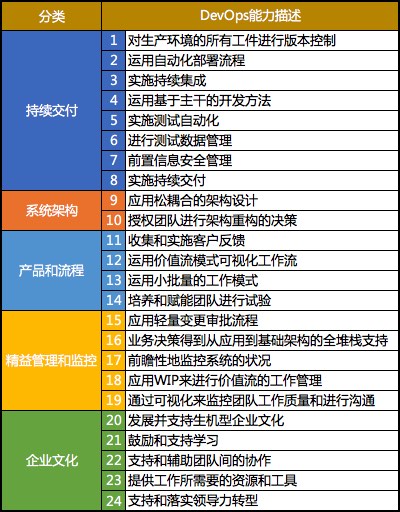听说这里有一个15分钟就能完成的DevOps调查问卷,有25位参与者或将得到总值为3200美元的亚马逊购物券。一年也就是这一次机会。问卷调查将在10天后就关闭。
这是DevOps状态报告调查问卷的第七年。在过去的6年里,已经有两万七千多人参与了这项调查。这项调查已经获得了丰硕的成果,主要是帮助你了解在DevOps之旅上当前的进展。今年又扩展了调查的范围,再度加深了对DevOps之旅的调研。
我已经帮你把问题的套路摸清楚了,其实问题都很清晰直白,很容易和你所在企业的DevOps状态做匹配。填写问卷调查也是一个学习的过程,可以用开放的心态去了解一下,调查报告对DevOps的观察角度都有哪些?
对其中的部分问题做出了简要的说明,预祝你在参加这项全球性著名调查的过程中,有一个愉快的体验。
今年的看点
据说DevOps状态调查报告的一个最大的价值就是:在你的组织中,你可以用这些数据展示出DevOps的价值,从而取得管理层的支持,并启动DevOps项目。
在今年的调查研究工作中,新加入的,对在企业中应用和推广DevOps有深度洞察的专家包括:
- Andi Mann, the chief technology advocate at Splunk and co-author of Visible Ops – Private Cloud and and The Innovative CIO.
- Michael Stahnke, a director of engineering at Puppet and the author of Pro OpenSSH.
- Alanna Brown, the director of product marketing at Puppet and creator of the first State of DevOps Report in 2013.
参加这项问卷调查将有25人会得到亚马逊购物券,价值 $100, $200 或 $500 ; 抽奖说明:
- $500 2 人
- $200 8 人
- $100 15 人
注:规则完整版 https://puppet.com/2018-devops-survey-contest-rules
参与此项调研报告
每道问题选择了答案之后,会影响到后续所出现的问题,我选择了金融(含保险)行业的DevOps软件工程师的路径。
这个调查的问题库非常强大,每一个问题的回答都在影响下一个问题的范围。有些问题是情景设定和分析题,会预设一个阶段(有可能是你还未达到的),在这种情况里作出你的判断和选择。
翻墙之后网页刷新速度会更快一些。

第一部分
- Where do you work? / 你在那个大洲工作?
- In which country do you work? / 在那个国家工作?
- What is the principal industry of your organization? / 你的组织是什么行业的?
- Which of the following best describes your title or role in your company? / 下面的各种头衔/角色那个和你最匹配?
- What department do you work in? / 你什么部门工作?
- And what team do you work on? / 你在什么团队工作?
- Which of the following describes your level of knowledge regarding your organization’s IT operations and software delivery? / 下面那一项最准确地描述了你的组织在IT运维和软件交付方面的知识程度?
第二部分
Many people say that there are four elements of DevOps that work together as enterprises evolve. They are:
- Culture 文化
- Automation 自动化
- Measurement 度量
- Sharing 分享
The next few questions will ask about each of these elements.
这部分是对企业的CAMS调查的。
Where would you say you are at culture-wise, on your DevOps journey so far? / 在你目前的DevOps旅程中,DevOps文化存在于怎样的范围里?
Where would you say you are at automation-wise, on your DevOps journey so far? / 在你目前的DevOps旅程中,自动化的程度是怎样的?
Where would you say you are at measurement-wise, on your DevOps journey so far? Please select all that apply. / 在你目前的DevOps旅程中,在那些方面实施了度量?- 多选
Where would you say you are at sharing-wise, on your DevOps journey so far? / 在你目前的DevOps旅程中,在分享方面是怎么做的?
How frequently do each of these practices occur in your organization? / 下列实践在你的组织中发生的频率?从来没用过 ~ 总是在用 5级
- We balance lowering technical debt, with new feature work
- Configurations are managed by a configuration management tool
- A cross-functional review is done before implementation of a project
- Teams use continuous delivery
- Before starting a project, we establish concrete success criteria
- We create learning opportunities across teams (e.g., training, internal DevOps workshops, etc.)
- We expose data and services via APIs
- Success metrics for projects are visible
- DevOps initiatives are supported by senior leadership
- Teams use agile approaches across development and operations
- Developers are on-call for production issues
- Teams use continuous integration
- Source code is made available to other teams
- Experiences and lessons are shared externally (e.g., meetups / conferences, blog posts, etc.)
How frequently were each of these practices used when you were first starting out with DevOps? / 在你的DevOps刚刚起步的阶段,下列实践的使用频率是怎样的?从来没用过 ~ 总是在用 5级
- Application configurations are in version control
- Infrastructure teams use version control
- Automate system configurations (e.g. operating system baselines)
- System configurations are in version control
- Automate provisioning (e.g. server, VM, cloud instances, etc.)
- Application development teams use version control
- Automate security policy configurations
How frequently were these practices used after you started to see some traction with DevOps? / 在你开始感受到DevOps的优势以后,下列实践的使用频率是怎样的?从来没用过 ~ 总是在用
- We reuse deployment patterns for building applications or services
- Monitoring and alerting are configurable by the team operating the service
- We deploy on a single standardized operating system
- We deploy on a set of standardized operating systems
- We build on a standardized set of technologies
- Configurations are managed by a configuration management tool
- We reuse testing patterns for building applications or services
How frequently were the following used while you were expanding DevOps practices? / 在你推广DevOps实践的过程中,下列实践的使用频率是怎样的?从来没用过 ~ 总是在用 5级
- We have post-incident reviews and share results
- Security teams are involved in technology design and deployment
- Teams contribute improvements to tooling provided by other teams
- We reuse testing patterns for building applications or services
- Individuals can do their work without manual approval from outside of their team
- We reuse deployment patterns for building applications or services
- Monitoring and alerting are configurable by team operating service
How frequently were these practices used while you were optimizing your DevOps practices? / 当你在优化DevOps实践的过程中,下列实践的使用频率是怎样的?从来没用过 ~ 总是在用 5级
- Infrastructure changes are tested before deploying to production
- Rearchitect applications based on business needs (e.g., reducing operational costs, ease of deployment, etc.)
- Individuals accomplish changes without significant wait times
- Monitoring and alerting are configurable by team operating service
- Teams contribute improvements to tooling provided by other teams
- Service changes can be made during business hours
- Incident responses are automated
How frequently were these practices used while you were enabling self-service? / 在你管理自助服务的情况下,下列实践的使用频率是怎样的?从来没用过 ~ 总是在用 5级
- Teams contribute improvements to tooling provided by other teams
- Resources (e.g., accounts, infrastructure, etc.) made available via self-service
- Logging configuration is deployed with the application or service
- Monitoring and alerting are configurable by team operating service
- App developers deploy testing environments on their own
Which, if any, of the following processes or tools are “self-service” in your DevOps approach? Please select all that apply. / 在你的DevOps计划中,下列哪些流程或者工具会做成自助服务?
Which of the following organizational structures have you used in your DevOps journey? / 在你DevOps的旅程中,你曾经用过下列哪些组织结构?
- Cross-functional teams that are responsible for specific services or applications
- A centralized IT team and multiple application development teams
- A Site Reliability Engineering (SRE) team
- A service provider that provides DevOps capabilities (e.g. builds test environments, provides monitoring, etc.)
- A dedicated DevOps team
Please tell us what kind of development your organization does. / 你的组织开发各种类型软件的比例是多少?5个问题填写百分比,凑够100
- We do custom development for internal users
- We do custom development for COTS (commercial off-the-shelf software)
- We manage COTS (commercial off-the-shelf software (e.g., upgrades)
- We do in-house development of custom applications for external users
If you could move the needle on one metric related to DevOps, what would it be? / 如果让你仅仅选择一个度量DevOps的指标,这个指标是什么? - 描述题
Just a few more questions to help us categorize your answers. / 下列问题帮助我们对你的组织进行分类。
What figure best describes your company’s annual revenue in US$ equivalent? / 你们公司的年营业额是多少美元?
What is the proportion of genders working on your team? / 你所在的团队男女比例?
Please tell us how you identify. / 请问告诉我们你认为自己是什么性别。
What is your current annual salary in US dollars? / 你的年薪是多少美元?
Do you consider yourself to be part of a visible or invisible minority where you work? / 你认为自己工作是显耀的还是无足轻重(少数派)的?
Please tell us of what minority(ies) you consider yourself to be a member. Please select all that apply. / 请告诉我们你的这种无足轻重是指哪方面?-多选
Would you like to receive an email with the report link when it is available? / 你是否希望收到这份报告的下载链接?
完毕

本文来源:https://puppet.com/blog/introducing-2018-state-devops-survey-new-research-focus
调查问卷网址:https://polls.onresearch.net/DevOps/blog
后记
DevOps圈子里的人都知道,这项问卷调查在IT行业里的知名度和权威性。它的目的在于:通过持续的研究DevOps在各个企业中应用的状态特征,定量的收集大量行业基础分析数据,这样所有的企业就有了一个可以参照的基线数据。更重要的是,它还将企业的绩效分成了高中低三个等级;对这些数据,用科学的分析方法,总结出了高绩效企业之所以高明的原因,将这些结论/假设/原因还在逐年推演和求证中。因此它形成了最具说服力的一些列结论。这些结论都展示在了历年来的DevOps状态报告中。
今年 Nicole Forsgren博士,《Accelerate》一书的主要作者,用此书对多年来的DevOps状态分析做了一个总结。此书一出版就高居亚马逊畅销榜榜首,还被誉为DevOps界的科学。这本书为你展示了历年来的状态分析报告是怎么来的?调查的范围和方向是如何演进的?为什么会得出这样的分析结果?

调查报告的分析结果是客观而科学的。而这本书向你展示了这些报告数据背后的How和Why。它提出了一个全新的主题“DevOps能力发展模型”;该书的一些结论也是非常具有颠覆性:
- 应用DevOps的企业不应该使用成熟度模型度量
- 应用DevOps的不同企业/部门不会参考某个共同标准
- 应用DevOps的不同企业/部门应该参考5大类24项的能力成长模型,来度量其发展进度,在磨练这些能力的过程中,选择符合自身业务需求的,且优先级别高能力先发展。
下图是24项能力的分解表:

我在这本刚发布的时候购买了电子版。在参加5月份的DevOpsDays大会北京站的深度培训“持续交付”课上,遇到了这个培训老师的Jez Humble先生,他也是本书的合著者之一。意外地获赠了一本他的签名实体书。

在学习了一段时间以后,我总结和归纳了一些内容:关于对DevOps能力发展模型的详细剖析,对24项DevOps主要发展能力之间的关联关系的解读;这些内容将会在8月份上海的DevOpsDays大会上呈现。
